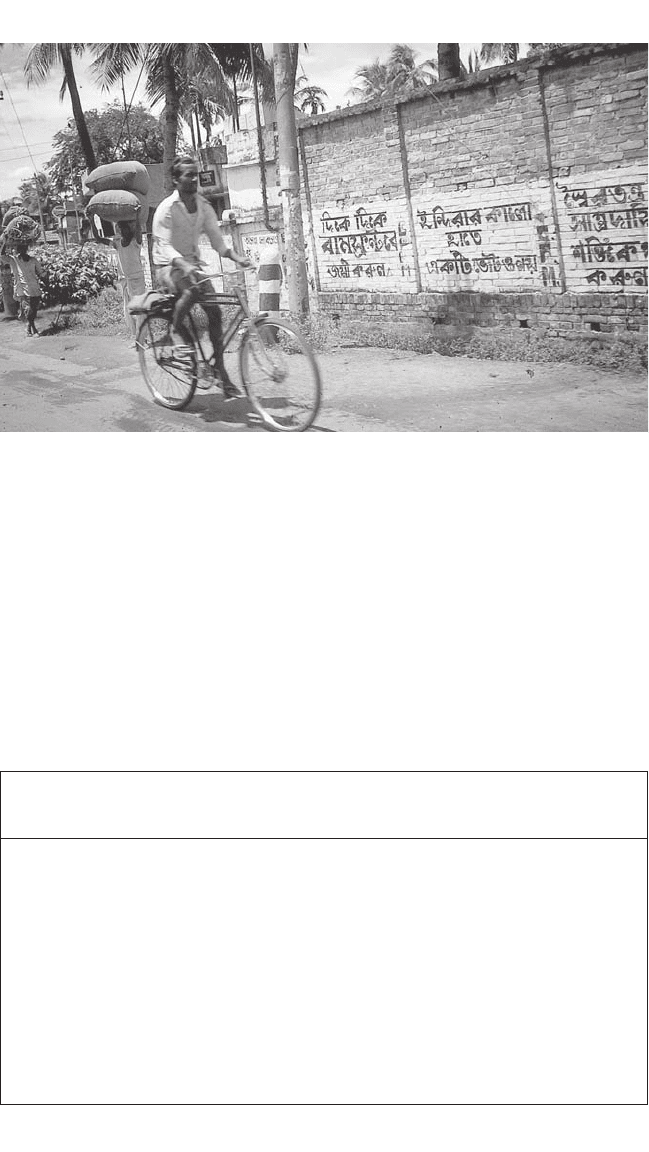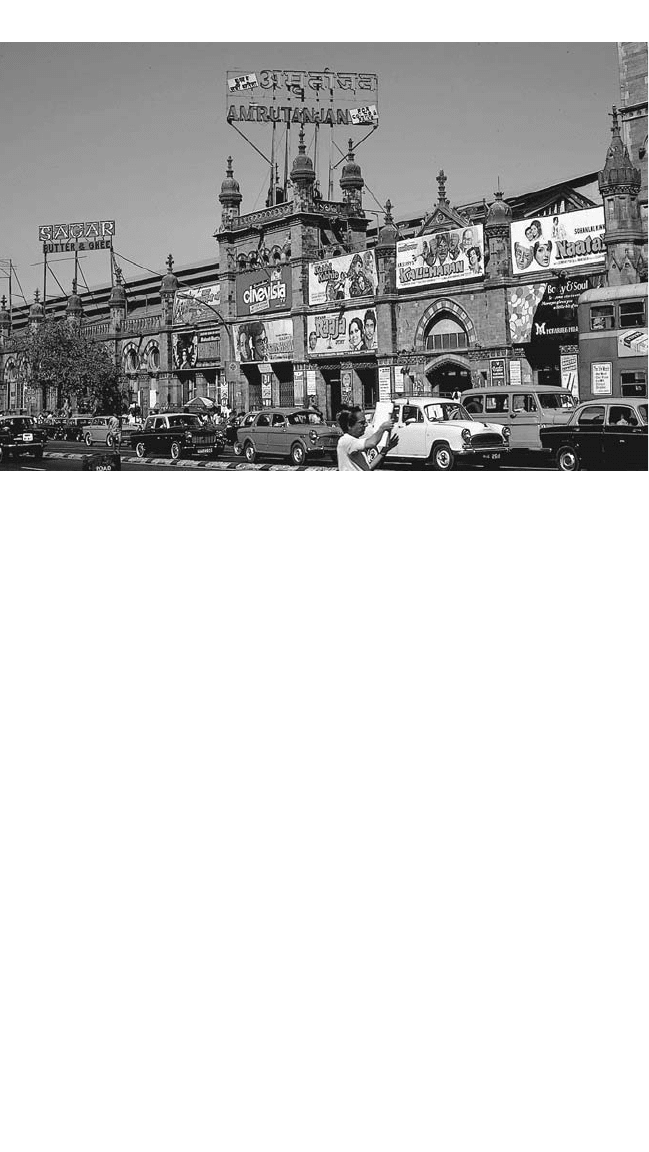Walsh J.E. A Brief History of India
Подождите немного. Документ загружается.


A BRIEF HISTORY OF INDIA
272
2 million in 1981 to 23.4 million in 1990. Packaged consumer goods
increased 220 percent between 1984 and 1990.
The 2001 census tabulations confi rm that it is urban Indians, not
villagers, who buy most of the consumer products made possible by
India’s new prosperity. In 2001, bicycles were almost equally present in
city and country households, but in the ownership of all other assets
city dwellers trumped villagers. While 65 percent of urban households
owned a television and 45 percent a radio, in the villages only 19 percent
had a television and 32 percent some type of radio. While 30 percent of
urban households had some kind of motor conveyance (a car, scooter, or
moped), in the villages only 8 percent of households owned any at all.
Village India was also home to many more of India’s most impoverished
citizens. Some households had no major assets whatsoever: 19 percent of
urban households and 40.5 percent of village households.
Predictions of a growing—and consuming—Indian middle class that
could number as many people as the populations of many Western
countries began to appear through media and news outlets in India and
the West as early as the late 1990s. For some, such as the author of The
Great Indian Middle Class, consumerism meant growing middle-class
selfi shness and the end of empathy for (or even interest in) the plight of
India’s poorest citizens (Varma 2007). For others, the prospects of a large
middle class and the increased liberalization of India’s economy meant
vast potential riches for all: Thus, the 2007 McKinsey Global Institute
analysts predicted in Bird of Gold: The Rise of India’s Consumer Market that
Assets in Urban and Rural Households, 2001
Percent of Urban Percent of Rural
Assets Households Households
Radio, transistor 44.5 31.5
Television 64.3 18.9
Telephone 23.0 3.8
Bicycle 46.0 42.8
Scooter, motorcycle, moped 24.7 6.7
Car, jeep, van 5.6 1.3
None of these assets 19.0 40.5
Source: Census of India, 2001. Offi ce of the Registrar General. January 7, 2004. Available
online. URL: http://www.censusindia.net. Accessed January 11, 2010.
001-334_BH India.indd 272 11/16/10 12:42 PM

273
BOLLYWOOD AND BEYOND
“Indian incomes will almost triple over the next two decades” and these
rising incomes would “lift 291 million out of poverty and create a 583
million–strong middle class” by 2025 (McKinsey 2007, 10–11).
By the turn of the century, analysts were acquiring a fi rmer grasp on
the potential size and composition of the new middle class. Based on
household surveys done at the turn of the century, the National Council
of Applied Economic Research (NCAER, a New Delhi economic and mar-
keting research fi rm) produced a Market Information Survey of Households
More than 80 percent of Indians own bicycles. The bicycle is one commodity found in almost
equal numbers in rural areas and urban cities.
(courtesy of Judith E. Walsh)
Size of the New Middle Class
(as determined by yearly household income)
Estimated Size of
Households with Middle Class Percent of Total
Yearly Incomes (in millions of people) Indian Population
Above Rs. 140,000 55 million 6%
Above Rs. 105,000 115 million 12%
Above Rs. 70,000 248 million 26%
Source: Sridharan, Dr. E. “The Growth and Sectoral Composition of India’s Middle Class:
Its Impact on the Politics of Economic Liberalization.” India Review 3, no. 4 (October
2004): 413–414. Figures are for 1998–99.
001-334_BH India.indd 273 11/16/10 12:42 PM

A BRIEF HISTORY OF INDIA
274
(MISH) that has been used by many analysts as the basis for estimating
the current size and composition of the new middle class. Unlike early
data that focused exclusively on consumption, the MISH data (published
in 2003) included income information from a sample of 300,000 urban
and rural households taken between 1998 and 1999. The survey divided
the Indian population into fi ve groups of households based on income
(rupees per year) as reported by household heads. The highest group
had incomes above Rs. 140,000; the upper middle group had incomes
between Rs. 105,001–Rs. 140,000; the middle group had incomes above
Rs. 70,000 to 105,000; the lower middle group, from above Rs. 35,000 to
Rs. 70,000; and the lowest group had incomes up to Rs. 35,000.
DEFINING THE MIDDLE CLASS
BY POSSESSIONS
T
he National Council of Applied Economic Research’s (NCAER)
1998–99 household survey enables analysts to estimate the new
middle class by income levels. An earlier survey in 1996 used self-
identifi cation, education, and consumption to estimate the size of the
new middle class and identify its composition. In 1996 the Centre for
the Study of Developing Societies (CSDS) in New Delhi surveyed
9,614 Indian men and women drawn from every state except Jammu
and Kashmir. The survey assumed an individual was middle class if he
or she met the following criteria: 1) The individual identifi ed him- or
herself as “middle class” and 2) The individual also possessed two
of the following four characteristics: (i) 10 years or more of formal
education; (ii) ownership of three out of four specifi ed assets (a
motor vehicle, a television, an electric generator or pump, and non-
agricultural land property); (iii) residence in a house built of brick and
cement; (iv) a white-collar job.
By these standards approximately 20 percent of the CSDS’s inter-
view subjects were middle class. Members of the upper castes (the
three highest varnas) and/or dominant landowning castes made up
only 25 percent of those surveyed but were nearly 50 percent of the
survey’s middle class. More surprising, however, was the discovery that
the other 50 percent of the survey’s middle class came from lower
castes, Untouchables, tribals, or religious minorities. Low ritual or
religious status had not stopped these respondents either from acquir-
ing middle-class assets or from thinking of themselves as middle class.
001-334_BH India.indd 274 11/16/10 12:42 PM

275
BOLLYWOOD AND BEYOND
The size of the new middle class depends on the criteria used to
defi ne it. Using NCAER data, Dr. E. Sridharan estimated in 2004 that
the size of the middle class fell between 55 million and 248 million
people, depending on which category of income one used to defi ne
it. The most restrictive defi nition of the middle class included only
households with yearly incomes above Rs. 140,000, or about 55 million
Indians; the next estimate of the middle class included all households
making more than Rs. 105,000 each year, or about 115 million people;
fi nally, the largest estimate of the middle class included members of all
households making above Rs. 70,000 each year, or about 248 million
people (Sridharan 2004, 414). Whatever defi nition is used to defi ne
(and count) the new Indian middle class, however, Sridharan points
out that its emergence has changed India’s class structure “from [an
earlier] one characterized by a sharp contrast between a small elite and
a large impoverished mass, to one with a substantial intermediate class”
(Sridharan 2004, 405).
The assumption, fairly widespread in news stories, that this emerg-
ing middle class comes entirely or even in the majority from India’s
higher castes or communities is challenged by an earlier 1996 survey
conducted by the Centre for the Study of Developing Societies (CSDS)
in New Delhi. This survey estimated the middle class (as defi ned by
self-defi nition, education, and possessions) at about 20 percent of its
survey sample but noted that nearly half of its members now came
from groups traditionally defi ned as among the lower castes (OBCs,
Untouchables, tribals, or religious minorities).
Indian Popular Culture
It was after independence and in the context of rapid population
growth, an urbanizing society, and (in the late 1980s and 1990s) a
growing consumer-oriented middle class that Indian popular culture
took its current form. A vibrant hybrid of old and new characterizes
today’s Indian fi lms, television serials, and audiocassette music. This
new popular culture has also marked India’s festivals and religious
cycles; in their new urban, middle-class forms, Indian holidays can
seem as much about consumerism as about religion.
For most of the 20th century Indian popular culture was dominated
by domestic fi lms and fi lm music. Indian radio began in 1927 but as
a government monopoly used mostly for educational programs. Only
in 1957 did All-India Radio (AIR) develop a new (and immediately
immensely popular) channel on which fi lm songs were played. The
001-334_BH India.indd 275 11/16/10 12:42 PM

A BRIEF HISTORY OF INDIA
276
Indian record industry was too expensive to serve more than a tiny
minority who could afford its record players and albums. Television
(also founded as a government monopoly in 1959) offered only a lim-
ited schedule, mostly of news and educational programs, until 1982.
Cinema tickets were much cheaper than televisions, record players,
or even radios. Films became the entertainment medium of choice
for Indian men in the decades after 1947. (Poor or lower-class Indian
women particularly from rural areas did not go to see fi lms although
they knew the songs from radio broadcasts.) Films were shown in
theaters in towns and cities and in traveling screen shows in villages.
Even the tiny television system broadcast a Hindi fi lm each week. For
40 years, from the 1930s to the 1970s, fi lm and fi lm music dominated
Indian popular culture, infl uencing musical tastes, fashion, speech, and
the worldviews of several hundred million viewers. Film songs were the
major—virtually the only—popular music in India.
The expansion of Indian television began in 1982–83: Doordarshan,
the government’s television organization, began to use Indian commu-
nication satellites to broadcast in color a new set of programs, including
the Asian Games of 1982 and the National Programme, sent from New
Delhi to stations throughout India. In 1982 Doordarshan’s 16 transmit-
ters reached less than 8 percent of Indian people, but in 1983 the Sixth
Five-Year Plan committed 869.5 million rupees to increase transmis-
sion facilities. By 1991 Doordarshan had 523 transmitters broadcasting
programs to 35 million TV sets and with the potential to reach almost
80 percent of the population. The expansion of Indian television added
a new video culture to that of Indian fi lms. Portable black-and-white
TVs (selling for 3,500 rupees) became a growing consumer product.
By 2001 more urban Indian households (64 percent) owned televisions
than owned radios (45 percent). Even in rural India, almost 19 percent
of households owned a television by 2001.
At the same time a new and inexpensive medium—audiocassette
tapes and players—suddenly made many different kinds of music and
audio programming cheaply available to Indian consumers. This new
technology created what ethnomusicologist Peter Manuel calls the
“cassette culture” of the 1980s and 1990s. Cassettes were produced for
a great variety of regional, local, and genre music, from regional folk
music to religious bhajans (Hindu devotional songs), popular ghazals
(Urdu poetry), obscene Punjabi truck driver songs, women’s liberation
songs, and Hindutva organizing songs. By the 1990s Hindi fi lm songs
had plummeted from 90 percent of Indian recorded music to less than
40 percent.
001-334_BH India.indd 276 11/16/10 12:42 PM

277
BollyWood And Beyond
Bollywood
film was first introduced in india in 1896 when six silent motion pictures
were shown in Bombay. But only after 1931, when the first indian sound
film was produced, did the commercial indian film industry begin. the
movies were made in Bombay production studios—called Bollywood, a
combination of Bombay and Hollywood—and in regional film centers
in southern and eastern india. (technically the largest number of films
are made in Chennai, formerly known as Madras; however, the south
indian languages used in these films limit their distribution.) Bollywood
films are shown in cities, towns, and villages throughout india. As of
2009, according to the annual report of the Ministry of information and
Broadcasting, indian filmmakers produced more than 1,200 feature films
each year, making the indian film industry the largest in the world. on
average, 11 million indians attend the cinema every day, down from 15
million in 1993 due to competition from satellite television and tV seri-
als. still on average, 4 billion indians go to the movies each year.
Most Bollywood films are musicals and follow a well-established
format, with naturalistic dialogue scenes interspersed with five or
six song sequences and at least three dance numbers. the song and
dance numbers make the films popular with viewers even outside the
Film posters compete for space on the wall of Mumbai’s (Bombay’s) Victoria Station. Films
(and film music) were virtually the only form of national popular culture until the advent of
cassette tapes and television serials in the 1980s.
(courtesy of Judith E. Walsh)

A BRIEF HISTORY OF INDIA
278
North Indian Hindi language belt. Most stories are contemporary and
domestic; only about 10 percent are mythological. Beginning in the
mid-1970s Bollywood began to produce action-oriented fi lms, fi lling
them with murder and mayhem, but most plots still contained confl icts
with romantic love set in the Westernized, modern upper-class world
of urban India. Characters frequent night clubs, drive sports cars, drink
alcohol, and wear Western clothing (if men) or fashionable versions of
traditional Indian clothing (if women). They struggle to resolve con-
fl icting attachments to romance on the one hand and family obligations
and loyalties on the other. Although for many years censorship rules
barred kissing in fi lms, fi lmmakers circumvented these restrictions
with voluptuous dance sequences and the famous “wet sari” sequences.
Endings are virtually always happy as romance triumphs over misun-
derstandings, family, dowry, and caste or class distinctions.
A MASALA HIT
T
he 1975 fi lm Sholay (Flames) was so unusual in style and content
for Bollywood that its failure was widely predicted. Instead, the
movie became one of Bombay’s most successful. Released during the
early days of Indira Gandhi’s Emergency, its stylish cinematography
and story of violence and social disorder struck a chord in receptive
Indian audiences. Sholay introduced the concept of the masala (spicy)
fi lm, a genre that added action, adventure, and violence to the basic
Bollywood formula of romance and family confl ict. Set in the harsh
plateau lands of the northern Deccan, Sholay was one of Bollywood’s
fi rst “curry Westerns.” In a relatively dark parable of the erosion of
traditional order, its story followed two outlaw adventurers, Veeru
and Jai, as they struggled to take revenge against a villainous dacoit
(bandit) who had maimed their patron, a local thakur (landlord/offi -
cial), and killed his sons.
Sholay sold out movie houses in major cities for more than two
years and set ticket records for profi tability that held for almost 20
years. Not just its songs, but even its dialogues were sold on audiocas-
settes and memorized by devoted fans throughout India.
Source: Quotation from Lutgendorf, Philip. “Sholay.” Philip’s Fil-Ums: Notes
on Indian Popular Cinema. 2002. Available online. URL: http://www.uiowa.
edu/~incinema/. Accessed February 10, 2010.
001-334_BH India.indd 278 11/16/10 12:42 PM

279
BOLLYWOOD AND BEYOND
Indian fi lmmakers deliberately strive to create a fantasy world in
Bollywood fi lms, a rich, upper-class Indian world in which all types of
consumer products are lavishly displayed. As one lower-class village
youth told an interviewer, “Ninety percent of the people I know want
everything they see in fi lms” (Manuel 1993, 266). Critics complain
that this Bollywood fi ctional world not only is elitist and upper middle
class but also is one in which the fairness of basic economic relation-
ships in Indian society is never questioned (nor, for that matter, is the
dominance of men within Indian families). Peasant characters, even
when impoverished, appear clean, well fed, and well clothed. Rural set-
tings bear little relation to actual villages. Bollywood fi lms have yet to
BOLLYWOOD ABROAD
T
he 1995 hit Dilwale Dulhania Le Jayenge (The lover will carry away
the bride) uses London, Europe, and the Punjab as the backdrop
for its story of middle-class romantic love thwarted by family elders.
In it Baldev Singh, an Indian émigré to London, returns home to the
Punjab to marry his daughter (betrothed at birth) to the son of his
best friend. She, unknown to him, is already in love with a brash but
decent Indian boy from England who follows her to the Punjab to win
her as his bride. The fi lm explores the confl icts of elders in the Indian
diaspora who long to return home—the song “Come home, stranger,
your country calls you back” is frequently reprised—and of a younger
expatriate generation eager to make its own way in life.
Dilwale Dulhania Le Jayenge sold out not only in India but among
Indian diasporic communities in Great Britain and North America.
Economically Bollywood’s interest in the nonresident Indian (NRI) audi-
ence made sense, for although the NRI community is small by Indian
standards (approximately 4 million potential viewers in Great Britain
and North America), ticket prices are much higher in these countries,
and the resulting profi ts substantial. The popularity of Hindi fi lms in the
overseas diaspora continued to grow during the 21st century. In 2000
four Hindi fi lms were among the top 20 releases of the year in the
United Kingdom. In 2003 Time magazine reported that the worldwide
audience for Indian fi lms (approximately 3.6 billion people) was more
than 1 billion greater than the audience for Hollywood fi lms (Guha).
Source: Guha, Ramachandra. India after Gandhi: The History of the World’s
Largest Democracy (New York: HarperCollins, 2007), p. 730.
001-334_BH India.indd 279 11/16/10 12:42 PM

A BRIEF HISTORY OF INDIA
280
approach the realistic (and empathetic) portraits of village India drawn,
for example, in the 1950s–80s fi lms of the world famous Bengali direc-
tor Satyajit Ray.
Even though Bollywood production studios turn out a large number
of fi lms each year, Bollywood’s “star system” ensures that only a small
number of producers, directors, actors, and singers work on these fi lms.
Bollywood fi lms have involved fewer than 70 such “stars” since the
1940s. The fees for these men and women can make up 65 percent of
a fi lm’s budget, and fi lms can sometimes take three years to complete
because stars may work in as many as 50 fi lms at one time.
Film Music
Hindi fi lm songs dominated the Indian music industry from the 1940s
to the 1970s. Unlike the West where popular music has long been gen-
erated by independent artists in concerts or in recordings, in India the
only popular music until very recently was fi lm music. Older Indian
folk music had a wide range of subjects and styles; it wove regional
culture into its songs through references to local customs, costumes,
foods, jewelry, and spices. In contrast, Hindi fi lm songs presented a
homogenized all-India culture shorn of regional characteristics. Tunes
had to be “so simple they can be hummed by everybody,” in the words
of one music director (Manuel 1993, 50).
Film music was (and is) studio art. Songs are performed in the stu-
dio by “playback singers,” whose singing provides the vocals while
fi lm actors mouth the words on screen. As in Bollywood more gen-
erally, only a small number of musicians work in fi lm songs. In the
1980s and 1990s some seven or eight music directors produced virtu-
ally all Bollywood fi lm music; an equally small number of musicians
wrote the scores and between fi ve and six “playback” singers recorded
them. The most famous of these singers was (and is) Lata Mangeshkar
(1929– ). Her high-pitched falsetto has been featured in several thou-
sand fi lm songs over the course of her career, especially from the 1940s
through the 1980s, so much so that she was featured in the Guinness
Book of Records as the singer of the most recorded songs in the world.
Mangeshkar and her sister Asha Bhosle (1933– ) together established
the female style of fi lm singing that dominates Bollywood fi lms even
today.
As Hindi fi lm music grew in popularity over the 20th century, Indian
folk songs began to make use of its music, style, and even of the songs
themselves. Hindu festivals such as the yearly Ramlila (the celebration
001-334_BH India.indd 280 11/16/10 12:42 PM

281
WOMEN’S LIB AND HINDUTVA
I
n the 1990s two specialized but very different producers of cas-
sette tapes were the women’s liberation organizations of India
and the Hindutva Ramjanmabhoomi organizers. In 1990 the New
Delhi women’s organization Jagori distributed three tapes of songs
and speeches on women’s issues. Jagori was one of perhaps 100
women’s groups that worked on issues such as women’s education,
domestic abuse, dowry murder, and female infanticide by organizing
at the grassroots level in urban and rural settings. The songs Jagori
taped were set to folk tunes, fi lm song melodies, and Muslim religious
music, and the tapes were either directly distributed or were used by
organizers in workshops and song sessions. One such song, set to a
Rajasthani folk tune, began
Hear how together with other women we can gain our rights
Brother got freedom, we got the four walls
Why don’t we smash these walls?
First we’ll demand our rights at home, and then outside as well.
(Manuel, 240)
In the same period organizers for the Ramjanmabhoomi movement
published four tapes of songs, chants, poetry, and speeches as part of
their campaign to build support for the demolition of the Babri Masjid
in Ayodhya. Offi cially the tapes were banned, but they were still eas-
ily available in North Indian cities. One tape featured Uma Bharati,
a woman BJP member of Parliament, urging followers to embrace
violence to build both the Ram temple and a stronger Hindu India:
May our race not be blamed, and may our mothers not say that
when we were needed, we weren’t ready.
If there must be a bloodbath then let’s get it over with
Because of our fear of a bloodbath before
Our country was divided [in partition]
Since their [the Muslims] arrival until today, they have killed so many
Hindus
We tried to appease them, but there was bloodshed after all
Instead of having it simmer slowly, it’s better to have it burst with a big fl ame
If they don’t understand our words, then we’ll make them understand
with kicks;
If there must be a bloodbath, then let it happen! (Manuel, 253–254)
Source: Manuel, Peter. Cassette Culture: Popular Music and Technology in North
India (Chicago: University of Chicago Press, 1993).
001-334_BH India.indd 281 11/16/10 12:42 PM
